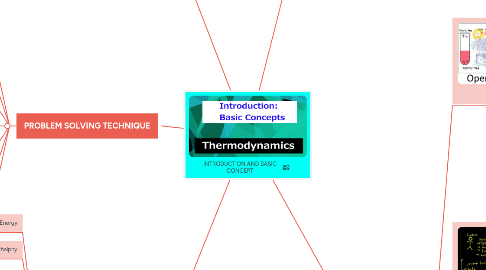
1. METRIC SI
1.1. Definition
1.1.1. The metric system is an internationally recognised decimalised system of measurement. It is now known as the International System of Units (SI). (Wikipedia)
1.2. Types
1.2.1. Base Units
1.2.1.1. meter for length
1.2.1.2. kilogram for mass
1.2.1.3. second for time
1.2.1.4. ampere for electric current
1.2.1.5. kelvin for temperatue
1.2.1.6. candela for luminous intensity
1.2.1.7. mole for quantity
1.2.2. Derived Units
1.2.2.1. Electromagnetism Quantities: volt, ohm, tesla, weber, farad, henry, siemens and coulomb
1.2.2.2. Mechanical Quantities: watt, newton, joule, pascal.
1.2.2.3. Electromagnetic Radiation: becquerel, sievert, lux, lumen
2. BASIC CONCEPT OF THERMODYNAMICS
2.1. System
2.1.1. Open System
2.1.1.1. Both matter and energy may transfer across the boundary of the system
2.1.2. Closed System
2.1.2.1. Only energy can transfer across the boundary
2.1.3. Isolated System
2.1.3.1. Neither matter or energy can transfer across the boundary
2.1.4. Properties
2.1.4.1. Extensive
2.1.4.1.1. Depend on the quantity of matter contained in a system
2.1.4.1.2. Examples: mass, volume, heat capacity, internal energy, enthalphy, entropy
2.1.4.2. Intensive
2.1.4.2.1. Depend only upon the amount of the substance present in the system
2.1.4.2.2. Examples: temperature, refractive index, density, surface tension, specific heat, freezing point, and boiling point
2.2. State of a System
2.2.1. the conditions of the system
2.2.2. States variable-observable properties
2.2.3. temperature (t), pressure (p), and volume (v)
2.2.4. State postulate
2.3. Process
2.3.1. Isochoric
2.3.1.1. Constant Volume
2.3.2. Isothermal
2.3.2.1. Constant Temperature
2.3.3. Isobaric
2.3.3.1. Constant Pressure
2.3.4. Adiabatic
2.3.4.1. No heat in or out the system
2.4. Equilibrium
3. PRESSURE AND TEMPERATURE
3.1. Temperature
3.1.1. Definition
3.1.1.1. Temperature is a physical quantity to measure hot and cold of an object
3.1.2. Temperature Scales
3.1.2.1. Celcius
3.1.2.2. Fahrenheit
3.1.2.3. Kelvin
3.2. Pressure
3.2.1. Absolute Pressure
3.2.1.1. zero-referenced against a perfect vacuum
3.2.2. Atmospheric Pressure
3.2.2.1. pressure exerted by the weight of the atmosphere, which at sea level
3.2.3. Gauge Pressure
3.2.3.1. zero-reference against ambient air pressure. (Pgauge=Pabs-Patm)
4. PROBLEM SOLVING TECHNIQUE
4.1. Problem Statement
4.2. Schematic
4.3. Assumptions and Approximattion
4.4. Physical Laws
4.5. Properties
4.6. Calculations
4.7. Reasoning, Verification and Discussion
5. VOCABULARY
5.1. Conservation of Energy
5.1.1. Energy cannot be created or destroyed
5.2. Enthalphy
5.2.1. To measure how much energy is produced or absorbed by a given reaction
5.3. Entrophy
5.3.1. a thermodynamic function used to measure the randomness or disorder of a system
5.4. Energy
5.4.1. the ability to do work or produce heat
5.4.1.1. Kinetic energy
5.4.1.2. Potential energy
5.5. State function
5.5.1. Property of the system that changes independently of its pathway
5.6. 1st Law of Thermodynamics
5.6.1. Heat in positive, work out negative
5.6.2. Energy of universe is conserved
5.7. 2nd Law of Thermodynamics
5.7.1. The state of the entropy of the entire universe, as an isolated system, will always increase over time
5.8. 3rd Law of Thermodynamics
5.8.1. The entropy of a perfect crystal is zero when the temperature of the crystal is equal to absolute zero (0 K)
